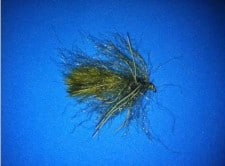The Floozie
Floozie
by trout mum
The Floozie evolved (that is, if you see it as an improvement) or mutated (if on the other hand, if you see it as a degenerate) from River Run’s Filoplume. Wanda, one of Carolyn’s favorite customers, was coming for her annual birthday guided trip. This new fly tying material from Enrico Puglusi had just arrived—Streamer Brush with rubber legs. The wild hairs, rubber legs and UV flash mixed into a Filoplume just seemed like it might jazz up the plain Jane and make the fly more exciting to the trout. So I whipped out three of them that morning, and Wanda and Carolyn took them out for fun. A phone call back to the shop from Carolyn with Wanda cackling in the background was confirmation the filoplume with flash and wiggles was a trout stopper! The Floozie was born.
Because the Floozie looks like a wooly bugger, it might imitate a small sculpin or leech. It also looks like a green glob of moss floating down stream. That moss is sometimes hides scuds or sow bugs, and the motion of this fly could be the enticement for the trout to pick it up. We fish the Floozie with a sink leader and swing and strip it like a wooly bugger. Letting it lie on the bottom and twitching it works sometimes in slower water. Sunny days are better for lighting up the UV material. When it works, well … it’s a Floozie!
Recipe
Hook: TMC 5263, size 10-12, (Carolyn likes the TMC 700)
Thread: Olive Uni thread 6
Tail: Olive wooly bugger marabou
Body: Peacock herl
Hackle: Olive EP Streamer Brush with rubber legs
Build a thread body between the eye and the bend of the hook. Cut a bushy piece of marabou that is the length of the hook shank and tie it in about a third of the way up the shank of the hook from the bend. Align the marabou so that it barely extends beyond the hook bend. Lay the streamer brush wire on the shank of the hook and tie it in where you tied on the marabou. Take three pieces of peacock herl and tie them in at the same junction. Wrap the thread back to the eye of the hook. Twist the peacock herl into a single strand and wrap it forward and tie off. Next palmer the streamer brush forward like a hackle, keeping the fibers brushed to the back as you go. You should make about five or six wraps. Tie it off and whip finish the head.







